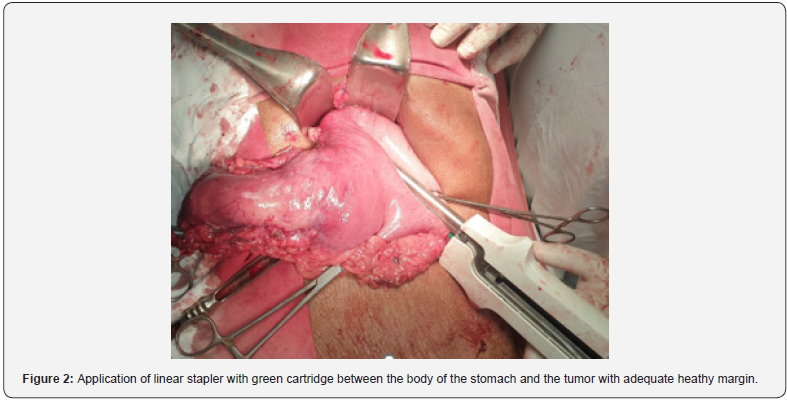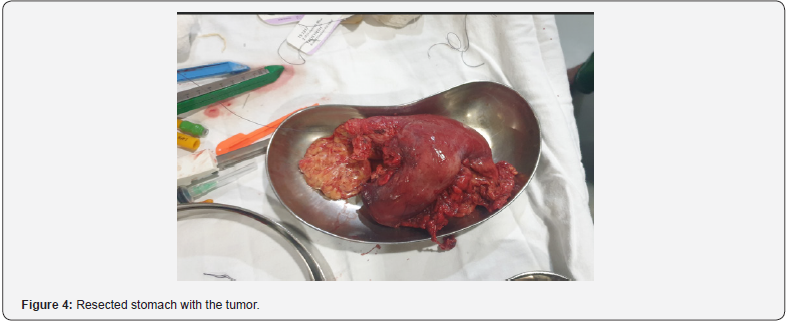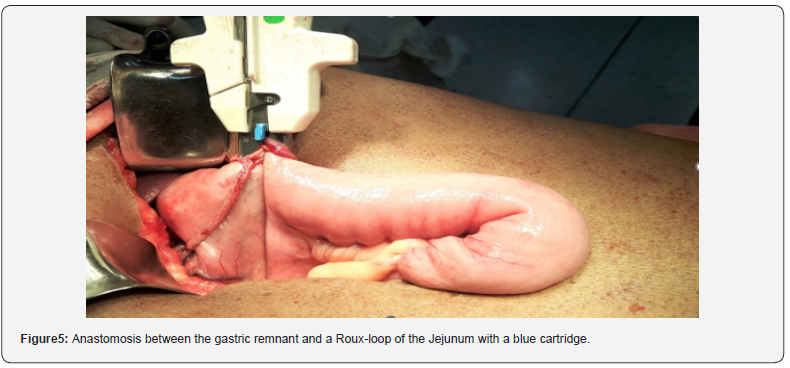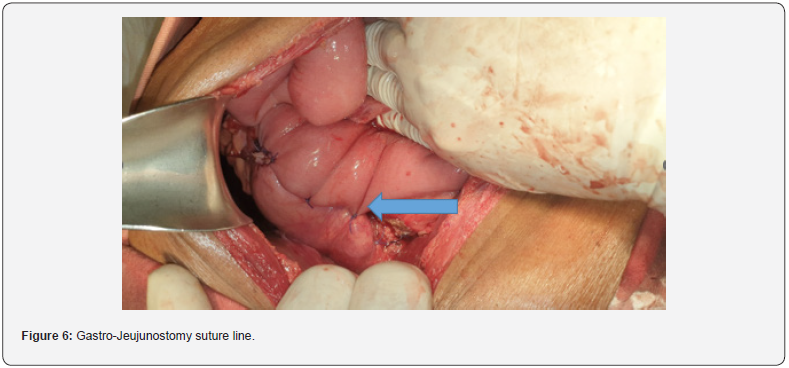Distal Radical Gastrectomy and Roux-Y Gastro-Jejunostomy for Carcinoma of The Antrum: How I Do It-Step by Step Surgical Technique
Sardar Rezaul Islam1*, Md Hanif Emon2 and Mahmood Kamal2
1Department of Surgery, Ad-Din Women’s Medical College Hospital (AWMCH), Dhaka, Bangladesh
2Department of Surgery, AWMCH, Bangladesh
Submission: May 24, 2023; Published: June 06, 2023
*Corresponding author: Sardar Rezaul Islam, Professor and Head, Department of Surgery, Ad-Din Women’s Medical College Hospital (AWMCH), Dhaka, Bangladesh
How to cite this article: Sardar Rezaul Islam*, Md Hanif Emon and Mahmood Kamal. Distal Radical Gastrectomy and Roux-Y Gastro-Jejunostomy for Carcinoma of The Antrum: How I Do It-Step by Step Surgical Technique. Open Access J Surg. 2023; 14(3): 555888. DOI: 10.19080/OAJS.2023.14.555888.
Abstract
A 75-year-old man presented with gastric outlet obstruction. He had a history of vomiting and weight loss for a period of 4 months. He had severe electrolyte imbalance, anemia, and malnutrition. CT scan revealed a huge antral carcinoma occupying distal half of the stomach. His anemia and electrolyte imbalance were corrected. He was given preoperative parenteral nutrition also. Stapler assisted distal radical gastrectomy and Roux-y gastro-jejunostomy was performed. He had an excellent post-operative recovery. He was discharged on resumption oral feeding and referred to oncologist for adjuvant therapy. In this article the steps of stapler assisted distal radical gastrectomy were described with a very clear operative picture.
Keywords: Antral cancer; Distal radical gastrectomy; Bill Roth -II gastro-jejunostomy; Roux- Y gastro-jejunostomy
Introduction
Gastric cancer (GC) is a highly malignant tumor with limited therapeutic effect. According to the latest statistics, over one million new cases of GC were diagnosed making it the fifth most common cancer and the fourth most lethal cancer type worldwide [1]. In the last few decades, great progress has been made in the treatment of GC, whereas radical surgical resection remains the only potential curative treatment option [2]. For most GC located in middle and lower stomach, particular in antrum and lesser curvature, distal gastrectomy (resection of the distal two-thirds of the stomach and anastomosis of the proximal stomach to the small bowel) is recommended [3]. Various reconstruction methods after distal radical gastrectomy have been introduced. The preferred approach is still controversial. Here, we reported a simplified and safe technique of Roux-en-Y anastomosis with linear cutter stapler.
Case Report
A 75-year-old man came with vomiting, weight loss for 4 months. He had generalized weakness, anemia, malnutrition, hyponatremia, hypokalemia, and hypoalbuminemia. There was a palpable ump in the epigastrium on abdominal examination. Upper GI endoscopy could not be done due to his frail condition. CT scan of the whole abdomen with oral and intra-venous contrast revealed large growth in the distal stomach occupying lower half of the stomach. There was no evidence of liver metastasis. He was prepared for surgery with gastric lavage, correction of anemia, correction of electrolyte abnormality and parenteral nutrition.
Surgical Technique
The abdomen was opened with upper abdominal incision. A huge antral cancer was found occupying the lower half of the stomach. The tumor was mobile and operable. Liver metastasis or peritoneal metastasis was not detected. Distal radical gastrectomy (DG) with Roux-Y gastro-jejunostomy was planned specially for small gastric remnant. Distal two-thirds of the stomach was mobilized and de-vascularized with ligature and vicryl suture. Duodenum was transected from the tumor by and blue cartridge linear cutter stapler (Auto-suture) (Figure 1). The duodenal stump was further reinforced with horizontal mattress suture with vicryl. The upper one-third of the stomach was divided from the tumor by two green cartridge linear cutter stapler (Figures 2-4). The jejunum was divided 30 cm distal the D-J flexure. The Proximal Roux loop was anastomosed with the stomach remnant with a blue cartridge linear cutter stapler (Figure 5). The window was closed with a single layer interrupted vicryl suture (Figure 6). The proximal jejunum was joined to the Roux-loop by end to side jejuno-jejunal anastomosis to restore intestinal continuity (Figure 7). The patient stayed five days in ICU and HDU with full support of parenteral nutrition. Oral feeding was resumed by the 7th postoperative day. He was discharged from the hospital on the 9th post operative day. His histopathology confirmed well differentiated adenocarcinoma with tumor free resection margin. Three lymph nodes had metastasis. He was referred to an oncologist for further adjuvant therapy. He was seen on a follow up visit after 2 weeks and was doing fine.







Discussion
Several studies revealed that stapled anastomosis is superior to manual hand-sewn anastomosis in terms of operating time and hospital stay [4,5]. So, stapled anastomosis is a preferable choice than the hand-sewn anastomosis for distal radical gastrectomy and Roux-Y reconstruction. Currently, Billroth-II and Roux-en-Y (R-Y) reconstructions are commonly performed after distal gastrectomy for gastric cancer. Traditionally R-Y reconstruction has been the reconstruction method of choice in total gastrectomy [6] and is being increasingly used to prevent duodeno-gastric and gastroesophageal reflux in DG [7,8]. The potential advantages of improved postoperative quality of life take precedence over the possible increased risk of postoperative complications due to multiple anastomoses and increased operating time in Roux -Y reconstruction. The operating time was significantly shorter in Bill Roth-2 gastrojejunostomy than Roux-Y gastrojejunostomy, which can be explained by the additional anastomosis in R-Y reconstruction. There is no difference in the rate of anastomotic leak within the two types of gastro-jejunostomy after DG. It may be largely due to the use of gastrointestinal stapling devices and the refinement of technique [9]. Roux-Y reconstruction following DG is superior to Bill Roth-II reconstruction for prevention of bile reflux, remnant gastritis and reflux esophagitis, as it reduces duodeno-gastric and gastroesophageal reflux [10,11].
Conclusion
Currently, Billroth-II and Roux-en-Y (R-Y) reconstructions are commonly performed after distal gastrectomy for gastric cancer. Which of these reconstruction procedures is superior remains controversial. However, most of the study favors Roux-Y reconstruction is superior due to prevention of bile reflux and gastroesophageal reflux.
References
- Sung H, Ferlay J, Siegel RL, Laversanne M, Soerjomataram I, et al. (2021) Global cancer statistics 2020: GLOBOCAN estimates of incidence and mortality worldwide for 36 cancers in 185 countries. CA Cancer J Clin 71(3): 209-249.
- Smyth EC, Nilsson M, Grabsch HI, van Grieken NC, Lordick F (2020) Gastric cancer. Lancet 396(10251): 635-648.
- Japanese Gastric Cancer Association (2021) Japanese Gastric cancer treatment guidelines 2018 (5th edn). Gastric Cancer 24(1): 1-21.
- Seo SH, Kim KH, Kim MC, Choi HJ, Jung GJ (2012) Comparative Study of Hand Sutured versus Circular Stapled Anastomosis for Gastrojejunostomy in Laparoscopy Assisted Distal Gastrectomy. J Gastric Cancer 12(2): 120-125.
- Anwar S, Hughes S, Eadie AJ, Scott NA (2004) Anastomotic technique and survival after right hemicolectomy for colorectal cancer. Surg J R Coll Surg Edinb Irel pp. 277-280.
- Kumagai K, Shimizu K, Yokoyama N, Aida S, Arima S, et al. (2012) Questionnaire survey regarding the current status and controversial issues concerning reconstruction after gastrectomy in Japan. Surg Today 42(5): 411-418.
- Shinoto K, Ochiai T, Suzuki T, Okazumi S, Ozaki M (2003) Effectiveness of Roux-en-Y reconstruction after distal gastrectomy based on an assessment of biliary kinetics. Surg Today 33: 169-177.
- Fukuhara K, Osugi H, Takada N, Takemura M, Higashi no M, et al. (2002) Reconstructive procedure after distal gastrectomy for gastric cancer that best prevents duodenogastroesophageal reflux. World J Surg 26: 1452-1457.
- Namikawa T, Kitagawa H, Okabayashi T, Sugimoto T, Kobayashi M, et al. (2011) Double tract reconstruction after distal gastrectomy for gastric cancer is effective in reducing reflux esophagitis and remnant gastritis with duodenal passage preservation. Langenbecks Arch Surg 396: 769-776.
- Shinoto K, Ochiai T, Suzuki T, Okazumi S, Ozaki M (2003) Effectiveness of Roux-en-Y reconstruction after distal gastrectomy based on an assessment of biliary kinetics. Surg Today 33: 169-177.
- Namikawa T, Kitagawa H, Okabayashi T, Sugimoto T, Kobayashi M, et al. (2010) Roux-en-Y reconstruction is superior to billroth I reconstruction in reducing reflux esophagitis after distal gastrectomy: special relationship with the angle of his. World J Surg 34(5): 1022-1027.






























